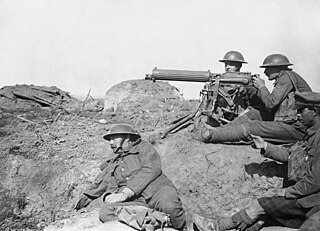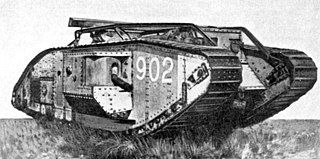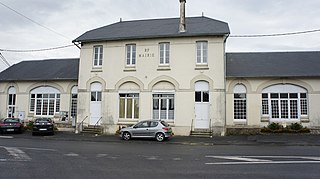
Trench warfare is a type of land warfare using occupied lines largely comprising military trenches, in which combatants are well-protected from the enemy's small arms fire and are substantially sheltered from artillery. It became archetypically associated with World War I (1914–1918), when the Race to the Sea rapidly expanded trench use on the Western Front starting in September 1914.

The history of the tank begins with World War I, when armoured all-terrain fighting vehicles were introduced as a response to the problems of trench warfare, ushering in a new era of mechanized warfare. Though initially crude and unreliable, tanks eventually became a mainstay of ground armies. By World War II, tank design had advanced significantly, and tanks were used in quantity in all land theatres of the war. The Cold War saw the rise of modern tank doctrine and the rise of the general-purpose main battle tank. The tank still provides the backbone to land combat operations in the 21st century.

Technology during World War I (1914–1918) reflected a trend toward industrialism and the application of mass-production methods to weapons and to the technology of warfare in general. This trend began at least fifty years prior to World War I during the American Civil War of 1861–1865, and continued through many smaller conflicts in which soldiers and strategists tested new weapons.

The Renault FT was a French light tank that was among the most revolutionary and influential tank designs in history. The FT was the first production tank to have its armament within a fully rotating turret. The Renault FT's configuration became and remains the standard tank layout. Consequently, some armoured warfare historians have called the Renault FT the world's first modern tank.

The Schneider CA 1 was the first French tank, developed during the First World War.

The Saint-Chamond was the second French tank to enter service during the First World War, with 400 manufactured from April 1917 to July 1918. Although not a tank by a strict definition of a heavily armoured turreted vehicle, it is generally accepted and described as such in accounts of early tank development. It takes its name from the commune of Saint-Chamond where its manufacturers Compagnie des forges et aciéries de la marine et d'Homécourt (FAMH) were based.

The Char 2C, also known as the FCM 2C, was a French post WWI heavy tank landship, later considered a super-heavy tank. It was developed during World War I but not deployed until after the war. It was, in total volume or physical dimensions, the largest operational tank ever made.
Jean Baptiste Eugène Estienne was a general of artillery and a specialist in military engineering, one of the founders of modern French artillery and French military aviation, and the creator of the French tank arm. He is considered by many in France to be the Père des Chars.

The development of tanks in World War I was a response to the stalemate that developed on the Western Front. Although vehicles that incorporated the basic principles of the tank had been projected in the decade or so before the War, it was the alarmingly heavy casualties of the start of its trench warfare that stimulated development. Research took place in both Great Britain and France, with Germany only belatedly following the Allies' lead.

Souain-Perthes-lès-Hurlus is a commune in the Marne department in north-eastern France.

The Frot-Laffly armoured roller, also Frot-Turmel-Laffly armoured roller, was an early French experimental armoured fighting vehicle designed and built from December 1914 to March 1915.

A mobile personnel shield is a type of bulletproof shield equipped with wheels. Such devices were employed experimentally during the trench warfare of World War I.

The Levavasseur project was an early project for a tank designed in 1903 by the French Captain Léon René Levavasseur (1860-1942) of the 6th Artillery Battalion, described as a "self propelled cannon project". It is considered as the first description, made by a soldier, of what would come to be known as the tank. Levavasseur was a graduate of Ecole Polytechnique, of the promotion of 1881. According to Armoured Fighting Vehicles of the World:
A project for a vehicle which had all the characteristics later thought desirable in a tank was put forward to the French War Ministry as early as 1903. Devised by a Captain Levavasseur of the 6th Artillery Battalion, who called it a "canon autopropulseur", the vehicle was envisaged as carrying a 75mm gun mounted in a box-like steel caisson which ran on crawler tracks, or "roues articulées" as Levavasseur called them. Powered by an 80hp petrol engine, the Levavasseur machine would have had a crew of three, storage for ammunition, and a cross-country ability.

The Breton-Prétot machine was an experimental wire-cutting device developed in France from November 1914. It was developed by Mr. Prétot, engineer, and Jules-Louis Breton, member of the French National Assembly.

The Souain experiment was a French military experiment using a Baby Holt Caterpillar, on the former battlefield of Souain, in northeastern France, on 9 December 1915. The experiment was a decisive influence on the French tank programme and initiated the design and order of the two French operational tanks, the Saint-Chamond and Schneider CA1.

Jules-Louis Breton was an inventor and a French politician. He was a representative of the French Assembly, and the proponent of the Breton-Prétot machine, a device developed in France from November 1914, intended to cut a way through barbed wire on the battlefield. It was developed with an engineer named Prétot, but did not progress beyond the experimental stage.

The Minerva Armoured Car was a military armoured car expediently developed from Minerva civilian automobiles by Belgium at the start of the First World War.

The Mortier de 220 mm Tir Rapide modèle 1915/1916 Schneider or 220 mm TR mle 1915/1916 was a French howitzer designed and produced during the First World War. A number were still on hand during the Second World War and served in Belgian, French and German service.
Renault armoured cars were a number of armoured car variants produced in France during the First World War.






















